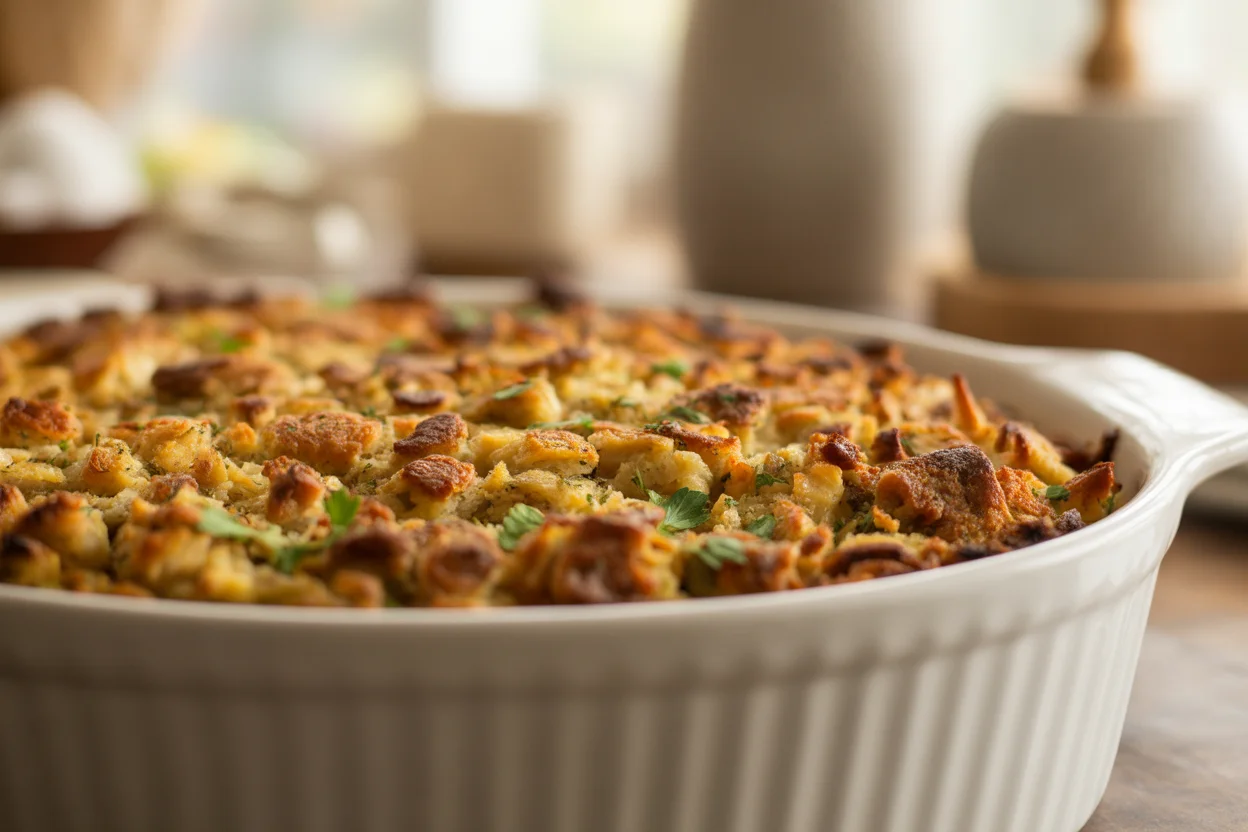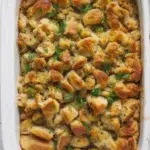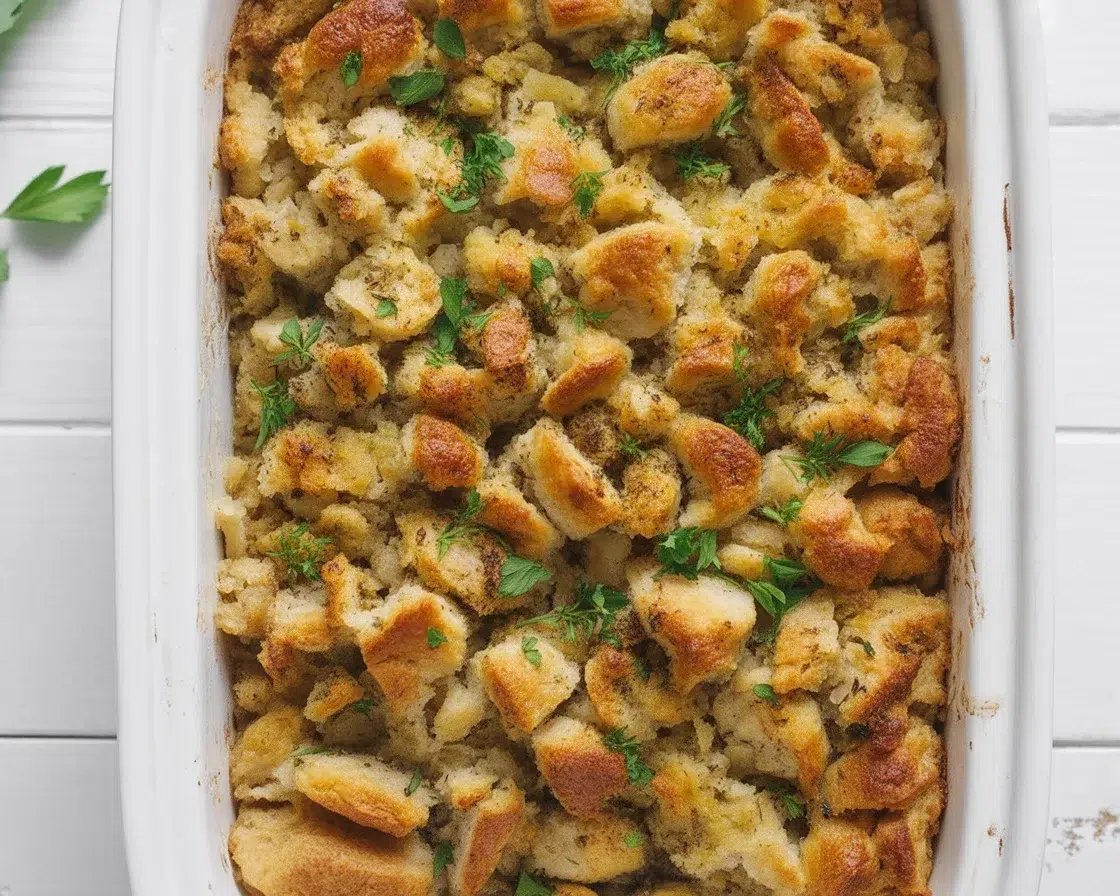thanksgiving stuffing recipe season is here, and if you have ever pulled a soggy pan from the oven or ended up with dry bread cubes that taste like cardboard, I have you. This is my go-to, cozy, no-stress version that turns out golden at the edges, tender in the middle, and loaded with savory flavor. It is the kind of side dish that makes people hover by the stove and ask for a spoon before dinner. We are talking buttery onions, celery that still has a little bite, and plenty of fresh herbs. If you have been hunting for a stuffing that actually tastes like home, this is it. 
Why Youll Love It
Think of this as the classic you grew up with, just a little smarter. It is simple, forgiving, and full of those cozy flavors everyone expects at Thanksgiving. The secret is a few small choices that change everything. I use dry, crusty bread so the cubes soak up flavor without turning mushy. I toast the bread just a bit more before mixing so you get a mix of textures. And I finish the pan uncovered so the top turns crisp and golden.
Another reason this works so well is the balance of seasoning. A mix of butter, onions, celery, garlic, and fresh herbs builds that rich, savory base. I like sage, thyme, and parsley, with a pinch of rosemary. The result is fragrant and almost meaty, even without sausage. If you do want sausage, I have a tip below for adding it without making the stuffing greasy.
If you are planning a big spread, stuffing pairs amazingly with other sides. I love serving it next to a creamy veggie bake for contrast. This green bean stuffing casserole is comfort on a plate and plays nicely with the herb notes here. You can also prep both in advance to save oven space on the day.
Bottom line, this is a thanksgiving stuffing recipe designed to be easy to love and hard to mess up. 
Key Ingredients in Stuffing
These are the basics that never fail me. Choose good ingredients and the rest almost takes care of itself.
- Bread: Use a sturdy loaf like French, sourdough, or country white. Day-old is good. Drier is better. Cut into 1-inch cubes.
- Butter: Real butter gives the stuffing that signature flavor and helps everything brown nicely.
- Onion and Celery: The classic duo. Cook them until soft and fragrant so their sweetness comes through.
- Garlic: Just a couple of cloves for warm, savory depth.
- Herbs: Fresh sage and thyme are key. Parsley lifts the whole dish at the end.
- Stock: Chicken or vegetable stock. Warm it before mixing so it absorbs evenly.
- Eggs: They bind the stuffing just enough so it slices while staying tender.
- Salt and Pepper: Season in layers. Taste as you go.
If you are a nostalgia person, you might love reading about a family staple like this Grandmas Thanksgiving stuffing. It is packed with those old-school touches we still crave.
Tip from experience: if your bread is not dry enough, spread the cubes on a sheet pan and bake at 300°F for 12 to 18 minutes, tossing once. You want them dry to the touch, with a hint of toast on the edges.
Another tip: if you use salted stock, hold back on the salt until the end. It is easier to add than subtract.
That is the backbone of a great thanksgiving stuffing recipe. 
How to Make Stuffing
I keep the process simple and relaxed so you can enjoy the day. Here is the flow that gives me consistent results.
- Prep the bread: Cube 1 to 1.25 pounds of sturdy bread. Dry it as noted above if needed.
- Cook the aromatics: In a large skillet, melt 8 tablespoons of butter over medium heat. Add 1 large diced onion and 3 to 4 diced celery stalks with a pinch of salt. Cook until soft and translucent, about 8 to 10 minutes. Stir in 2 minced garlic cloves and cook 1 minute more.
- Herb it up: Stir in 2 tablespoons chopped fresh sage, 1 tablespoon thyme, and 2 tablespoons parsley. Remove from heat so the herbs do not burn.
- Mix the base: In a huge bowl, combine the bread cubes with the buttery onion mixture. Toss well so every piece gets a little love.
- Add liquid: Whisk 2 cups warm stock with 2 beaten eggs. Pour over the bread mix gradually, tossing gently. The bread should feel moist but not soggy. If a handful squeezed makes a light clump that falls apart, you are there. Add more stock in small splashes if needed.
- Taste and season: Add salt and pepper. If you want a richer profile, stir in a small handful of grated Parmesan.
- Pan it up: Transfer to a buttered 9×13-inch baking dish. Cover with foil.
- Bake: Bake at 350°F for 30 minutes covered, then uncover and bake 20 to 30 minutes more until the top is golden and crisp and the center is set.
- Rest: Let it rest 10 minutes. This helps the texture settle and slice cleanly.
Made this for Friendsgiving and it vanished before the turkey was carved. Perfectly crisp on top, tender in the middle, and that buttery herb flavor is unreal. This is going into my yearly lineup.
Want to add sausage without greasiness? Brown 12 ounces of bulk sausage separately and drain well. Fold it in right before the mixture goes into the baking dish. You get all the flavor without the extra fat weighing things down.
Little pro move: drizzle the top with 1 to 2 tablespoons of melted butter before the uncovered bake. It helps the crust turn deeply golden.
That is the heart of this thanksgiving stuffing recipe. It is more about small, smart steps than chef tricks.
What Temperature Should You Cook Stuffing?
For oven temperature, 350°F is the sweet spot for even cooking. You will get a tender center without drying out the edges. If you want deeper browning, finish the last 5 to 10 minutes at 375°F, watching closely.
For doneness, make sure the center of the stuffing reaches 165°F on an instant-read thermometer. This is especially important if you include eggs, stock, or sausage. If you bake your stuffing inside the turkey, check both the turkey and the stuffing in the cavity for 165°F. If the bird hits temp before the stuffing, scoop it out into a dish and finish it in the oven so everyone stays safe.
Timing guide I use:
9×13-inch pan at 350°F: 30 minutes covered, 20 to 30 minutes uncovered. If you have a deeper pan, you may need an extra 5 to 10 minutes. If it is browning too fast, lay a loose foil tent on top to protect the crust while the center finishes.
Storage and Make-Ahead Tips
Make-ahead is the secret to a calm holiday. You can prep the entire dish a day in advance and bake it fresh, or bake it fully and reheat.
For mix-ahead: assemble the stuffing through the mixing step, then cover the dish tightly and refrigerate up to 24 hours. Remove from the fridge 30 to 40 minutes before baking so it is not ice cold. If it looks dry, splash on a little warm stock before it goes into the oven.
For bake-ahead: bake completely, cool, cover, and refrigerate up to 3 days. Reheat covered at 325°F for 20 to 30 minutes, then uncover for 10 minutes to re-crisp the top. Add a few tablespoons of stock if needed to bring back moisture. You can also reheat individual portions in a skillet with a bit of butter to revive the crisp edges.
Freezing: bake, cool, wrap well, and freeze up to 2 months. Thaw in the fridge, then reheat covered until hot, uncovering at the end. It will not be quite as perfect as fresh, but it still hits the spot.
Serving tip: Pair your stuffing with a simple green side and a bright dessert so the plate feels balanced. If you need sweet ideas, peek at these desserts worthy of drooling for Thanksgiving. And if you want more fresh spins for the whole menu, check out these unique Thanksgiving recipes that will dazzle without stress.
Common Questions
Can I use boxed bread cubes?
You can, but I get better texture and flavor from fresh bread that I cube and dry myself. If you do use boxed cubes, watch the salt since many are already seasoned.
How do I fix stuffing that looks dry?
Sprinkle on warm stock, a few tablespoons at a time, and gently fluff with a spoon. Cover with foil and return to the oven for 5 to 10 minutes. That usually does the trick.
What if my stuffing is soggy?
Spread it thinner in the pan and finish baking uncovered so steam can escape. You can also boost the oven to 375°F for the last few minutes to help set the center.
Can I make a vegetarian version?
Absolutely. Use vegetable stock and skip the sausage. A handful of sautéed mushrooms adds a savory kick. Keep the same method and bake times.
How many times should I say it is my favorite?
Enough times so you remember it. This thanksgiving stuffing recipe has been the one I return to every year because it is reliable, cozy, and crowd-pleasing.
A Cozy Plate Worth Repeating
Stuffing should be the dish that makes the kitchen smell like the holidays and the table feel warm. With sturdy bread, buttery aromatics, and a little care with moisture, this thanksgiving stuffing recipe delivers every time. If you want more ideas or a different spin, I love the buttery herb vibes in this best stuffing recipe, the step-by-step clarity from this Thanksgiving stuffing tutorial, and the heartwarming family touch in Grandmas classic turkey stuffing. Now it is your turn to bake a pan, taste the edges, and claim the corner piece. Save this one, make it your own, and enjoy every bite with your favorite people.

Thanksgiving Stuffing
Ingredients
Method
- Cube the bread and dry it if needed in the oven at 300°F for 12 to 18 minutes.
- In a large skillet, melt the butter over medium heat. Add the onion and celery with a pinch of salt. Cook until soft, about 8 to 10 minutes.
- Stir in the minced garlic and cook for 1 minute more.
- Remove from heat and stir in the chopped herbs.
- In a large bowl, combine the bread cubes with the onion-herb mixture and toss well.
- Whisk together the warm stock and beaten eggs, then pour over the bread mixture gradually, tossing gently until the bread is moist but not soggy.
- Taste and season with salt and pepper, adding Parmesan if desired.
- Transfer to a buttered 9x13-inch baking dish and cover with foil.
- Bake at 350°F for 30 minutes covered, then uncover and bake for 20 to 30 minutes more until the top is golden and crisp.
- Let rest for 10 minutes before serving.

